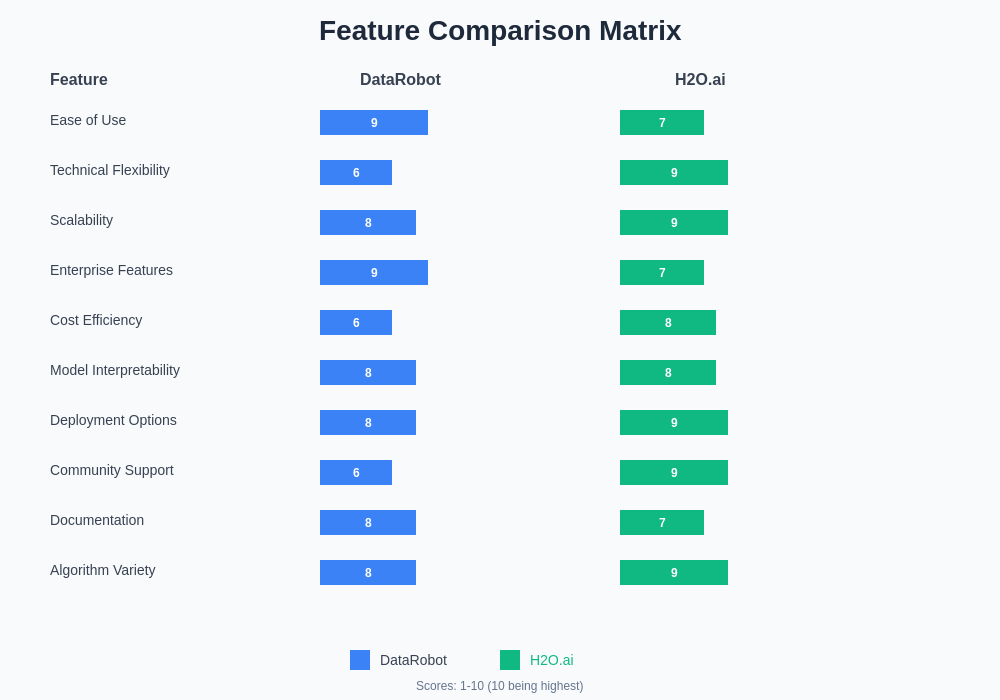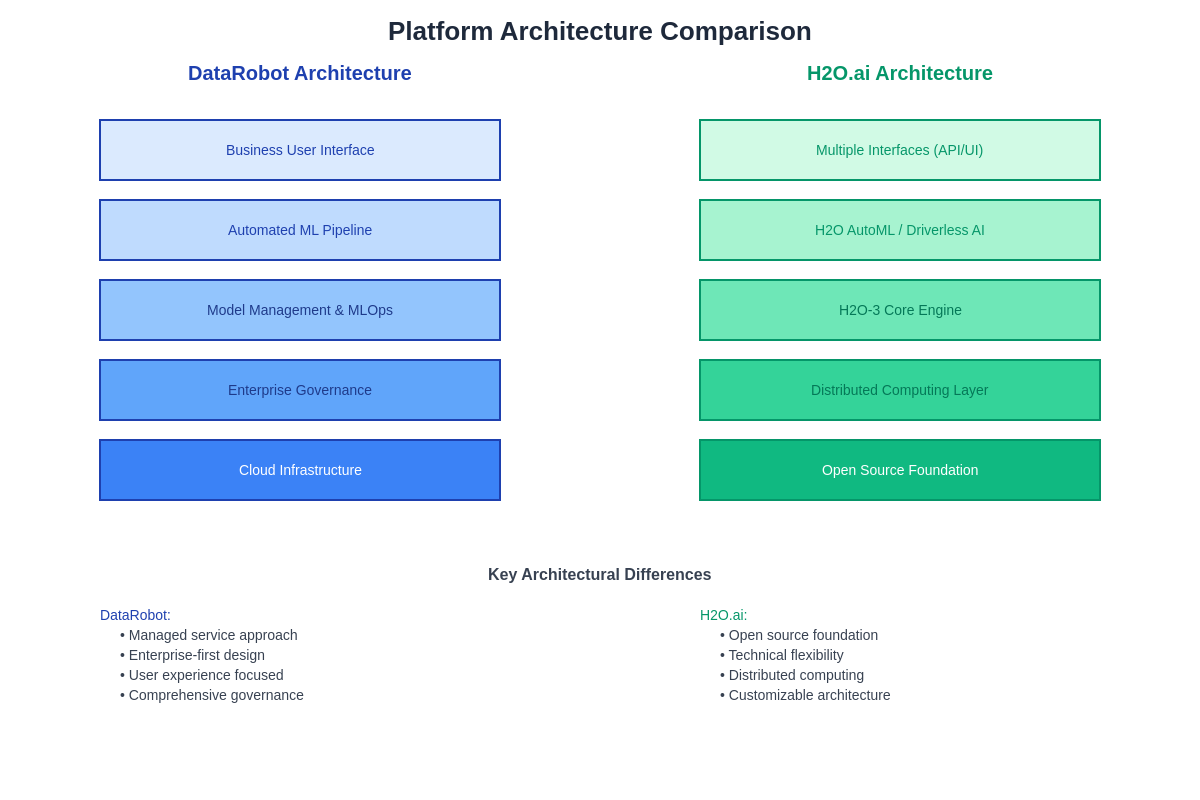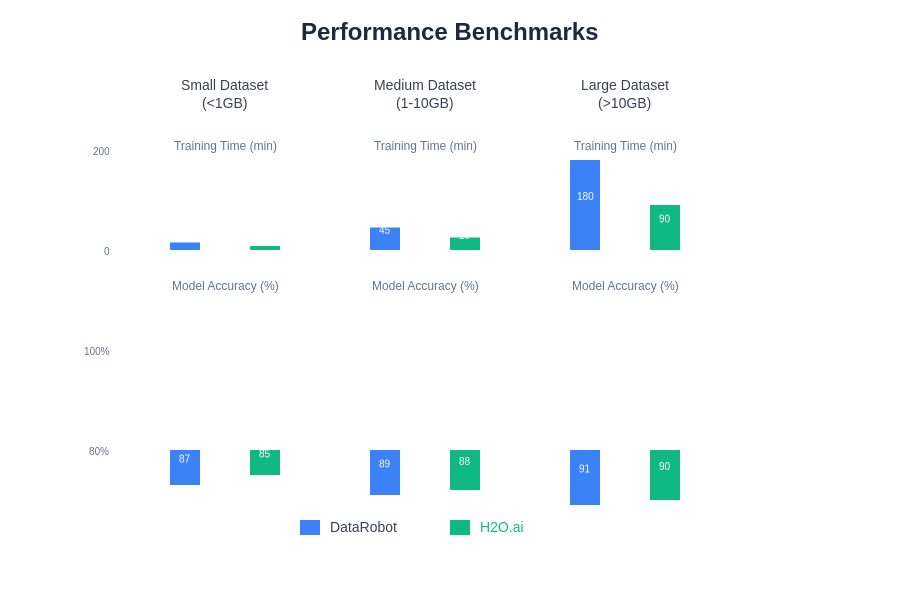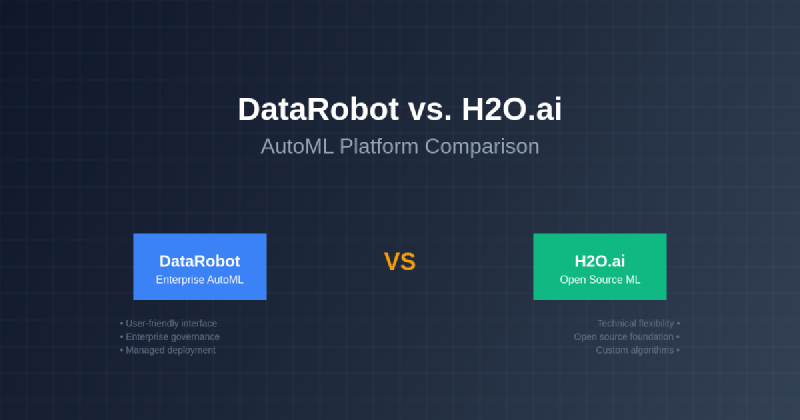The automated machine learning landscape has evolved dramatically with the emergence of sophisticated platforms that democratize advanced analytics and predictive modeling capabilities. Among the most prominent solutions in this space stand DataRobot and H2O.ai, two industry-leading platforms that have revolutionized how organizations approach machine learning implementation. This comprehensive analysis explores the nuanced differences between these powerful AutoML solutions, examining their respective strengths, limitations, and optimal use cases to provide decision-makers with the insights necessary for making informed platform selections.
Stay updated with the latest AI and machine learning trends that are shaping the future of automated machine learning and data science applications. The choice between DataRobot and H2O.ai represents more than a simple vendor selection; it reflects strategic decisions about organizational data science capabilities, deployment preferences, and long-term analytical infrastructure requirements.
Understanding AutoML Platform Fundamentals
The automated machine learning ecosystem has matured significantly, with platforms like DataRobot and H2O.ai representing different philosophical approaches to democratizing machine learning capabilities. DataRobot emphasizes enterprise-grade automation with extensive governance features and user-friendly interfaces designed for business analysts and citizen data scientists. In contrast, H2O.ai provides a more technically oriented platform that offers greater flexibility and customization options while maintaining powerful automation capabilities that appeal to data science professionals and technical teams.
Both platforms address the fundamental challenge of making machine learning accessible to organizations with varying levels of technical expertise while ensuring that the resulting models meet enterprise standards for accuracy, interpretability, and regulatory compliance. The distinction lies in how each platform balances automation with control, user experience with technical depth, and ease of deployment with customization capabilities.
DataRobot Platform Architecture and Capabilities
DataRobot has established itself as a comprehensive enterprise AutoML platform that prioritizes user experience and business value delivery through its sophisticated automation engine. The platform’s architecture centers around an intelligent automation framework that can process diverse data types, automatically engineer features, select optimal algorithms, and tune hyperparameters while providing extensive model interpretability and governance features that meet enterprise requirements for transparency and regulatory compliance.
The platform’s strength lies in its ability to handle the entire machine learning lifecycle from data preparation through model deployment and monitoring, with particular emphasis on making advanced techniques accessible to users without deep technical backgrounds. DataRobot’s automated feature engineering capabilities can identify and create meaningful predictors from raw data, while its ensemble modeling approaches often produce highly accurate predictions that rival custom-built solutions developed by experienced data scientists.
Enhance your data science workflow with advanced AI assistants like Claude that can help analyze complex datasets, generate insights, and support decision-making processes throughout your AutoML implementation journey. The integration of intelligent assistance tools can significantly accelerate the evaluation and implementation of AutoML platforms while ensuring optimal configuration for specific use cases.
H2O.ai Platform Architecture and Technical Foundation
H2O.ai represents a different approach to automated machine learning, emphasizing open-source foundations, technical flexibility, and scalable distributed computing capabilities. The platform’s architecture is built around the H2O-3 machine learning engine, which provides high-performance, in-memory processing capabilities that can handle large datasets efficiently across distributed computing environments. This technical foundation enables H2O.ai to excel in scenarios requiring custom algorithm implementations, advanced statistical modeling, and integration with existing data infrastructure.
The platform offers multiple interfaces including H2O AutoML for automated model building, H2O-3 for custom machine learning development, and Driverless AI for end-to-end automated machine learning workflows. This multi-layered approach allows organizations to choose the appropriate level of automation and customization based on their technical capabilities and project requirements, making it particularly attractive to data science teams that value flexibility and control over their modeling processes.

The comprehensive feature analysis reveals distinct advantages for each platform across different aspects of the machine learning lifecycle. While both platforms excel in core AutoML capabilities, their strengths diverge in areas such as user experience design, technical customization options, deployment flexibility, and integration capabilities with existing enterprise systems.
User Experience and Interface Design Philosophy
The user experience represents one of the most significant differentiators between DataRobot and H2O.ai, reflecting their different target audiences and design philosophies. DataRobot prioritizes intuitive workflows and visual interfaces that enable business users and analysts to build sophisticated models without extensive programming knowledge. The platform’s guided workflows, automated insights, and comprehensive visualizations create an experience that emphasizes accessibility while maintaining the power and sophistication needed for enterprise-grade machine learning applications.
H2O.ai takes a more technical approach to user experience, providing powerful APIs, programming interfaces, and customization options that appeal to data scientists and machine learning engineers. While the platform includes user-friendly interfaces through Driverless AI, its strength lies in providing the flexibility and control that technical users require for complex modeling scenarios. This approach enables advanced users to implement custom algorithms, modify existing approaches, and integrate H2O.ai capabilities into existing data science workflows and infrastructure.
Performance and Scalability Characteristics
Performance considerations play a crucial role in AutoML platform selection, particularly for organizations dealing with large datasets or requiring real-time model inference capabilities. DataRobot’s architecture is optimized for enterprise workloads with robust infrastructure management, automatic scaling capabilities, and efficient resource utilization that can handle diverse data volumes and computational requirements. The platform’s managed cloud infrastructure ensures consistent performance while abstracting the complexity of distributed computing from end users.
H2O.ai’s performance characteristics stem from its distributed computing foundation, which enables exceptional scalability for large-dataset processing and model training scenarios. The platform’s in-memory processing capabilities and optimized algorithms can deliver superior performance for computationally intensive tasks, particularly when deployed on appropriate infrastructure. However, realizing these performance benefits may require more technical expertise in system configuration and optimization compared to DataRobot’s managed approach.
Algorithm Selection and Model Development Approaches
The algorithmic capabilities and model development methodologies represent core differentiators between these platforms, influencing the types of problems they can address and the quality of resulting solutions. DataRobot employs a comprehensive algorithm library that includes traditional machine learning methods, deep learning approaches, and advanced ensemble techniques. The platform’s automated algorithm selection process evaluates multiple approaches simultaneously, creating diverse model portfolios that are then combined into high-performing ensemble solutions.
H2O.ai provides extensive algorithmic flexibility through its open-source foundation, enabling users to access cutting-edge machine learning techniques, implement custom algorithms, and modify existing approaches to meet specific requirements. The platform’s algorithm library includes distributed versions of popular machine learning methods optimized for performance and scalability, along with advanced capabilities such as automatic feature engineering, hyperparameter optimization, and model interpretability tools.
Leverage advanced research capabilities with Perplexity to stay informed about the latest algorithmic developments and research findings that could influence your AutoML platform selection and implementation strategy. Continuous learning about emerging techniques ensures optimal utilization of platform capabilities and identification of new opportunities for improvement.
Deployment and MLOps Integration Capabilities
Modern machine learning initiatives require robust deployment and operational capabilities that extend beyond model development to include monitoring, maintenance, and lifecycle management. DataRobot addresses these requirements through comprehensive MLOps functionality that includes automated model deployment, performance monitoring, drift detection, and governance workflows designed for enterprise environments. The platform’s deployment options span cloud, on-premises, and hybrid configurations while providing consistent management interfaces and operational controls.
H2O.ai’s deployment capabilities leverage its flexible architecture to support diverse deployment scenarios, from traditional batch processing to real-time inference systems. The platform’s integration capabilities enable seamless incorporation into existing data infrastructure and application architectures, though achieving optimal deployment configurations may require more technical expertise compared to DataRobot’s managed deployment options. H2O.ai’s open-source foundation also facilitates custom deployment solutions and integration with specialized infrastructure requirements.

The architectural differences between DataRobot and H2O.ai reflect their distinct approaches to balancing automation with flexibility, user accessibility with technical control, and managed services with open-source customization capabilities. Understanding these architectural distinctions helps organizations align platform selection with their technical requirements and operational preferences.
Pricing Models and Total Cost of Ownership
Cost considerations encompass both direct platform licensing fees and indirect costs related to implementation, training, and ongoing operational requirements. DataRobot typically employs enterprise licensing models that include comprehensive support, managed infrastructure, and professional services, resulting in higher upfront costs but potentially lower total cost of ownership for organizations that value managed services and comprehensive support. The platform’s pricing structure often correlates with the level of automation, user count, and computational resources required.
H2O.ai offers more flexible pricing options that reflect its open-source foundation and diverse deployment models. Organizations can leverage open-source H2O-3 capabilities at no licensing cost while paying for commercial features, support, and managed services as needed. This approach can result in lower initial costs but may require higher internal investment in technical expertise and infrastructure management to realize optimal value from the platform.
Industry-Specific Applications and Use Cases
Different industries and use cases may favor one platform over another based on specific requirements, regulatory constraints, and organizational characteristics. DataRobot’s enterprise focus and comprehensive governance capabilities make it particularly attractive for highly regulated industries such as financial services, healthcare, and insurance, where model interpretability, audit trails, and compliance features are critical requirements. The platform’s user-friendly interface also appeals to organizations with limited data science expertise but significant business analytics needs.
H2O.ai’s technical flexibility and performance capabilities make it well-suited for organizations with strong technical teams, complex analytical requirements, or specialized use cases that benefit from custom algorithm development. The platform excels in scenarios requiring integration with existing data science workflows, custom model development, or deployment in specialized infrastructure environments where flexibility and control are prioritized over ease of use.
Integration and Ecosystem Connectivity
Enterprise machine learning initiatives require seamless integration with existing data infrastructure, business intelligence tools, and operational systems. DataRobot provides extensive integration capabilities through APIs, connectors, and partnerships with major cloud providers and enterprise software vendors. The platform’s integration approach emphasizes simplicity and reliability, enabling organizations to incorporate automated machine learning capabilities into existing workflows without extensive technical integration projects.
H2O.ai’s integration capabilities leverage its open architecture and extensive API support to enable flexible connectivity with diverse data sources, analytical tools, and deployment environments. The platform’s integration strength lies in its ability to function as a component within larger data science ecosystems, providing specialized machine learning capabilities that complement existing tools and workflows while maintaining the flexibility to adapt to changing requirements.
Model Interpretability and Explainability Features
The increasing emphasis on responsible AI and regulatory compliance has made model interpretability a critical consideration for AutoML platform selection. DataRobot addresses these requirements through comprehensive explainability features that include LIME, SHAP, and proprietary interpretation methods designed for business users. The platform’s interpretation capabilities extend beyond technical explanations to provide business-relevant insights that help stakeholders understand model behavior and decision-making processes.
H2O.ai provides robust interpretability capabilities through its machine learning interpretability toolkit and integration with leading explainability frameworks. The platform’s approach to interpretability emphasizes technical depth and customization capabilities, enabling data scientists to implement specialized interpretation methods and adapt explanations to specific regulatory or business requirements. This flexibility makes H2O.ai particularly valuable for organizations with sophisticated interpretability requirements or specialized compliance needs.

Comprehensive performance analysis across different use cases and dataset characteristics reveals the nuanced performance trade-offs between DataRobot and H2O.ai. While both platforms deliver competitive results, their optimal performance scenarios differ based on factors such as dataset size, problem complexity, and technical implementation requirements.
Support and Professional Services Ecosystem
The availability and quality of support services can significantly influence the success of AutoML implementations, particularly for organizations with limited internal expertise. DataRobot provides comprehensive support services including technical assistance, professional services for implementation and optimization, and extensive training programs designed for users with varying technical backgrounds. The platform’s support ecosystem emphasizes customer success through managed services and guided implementation approaches.
H2O.ai’s support model reflects its open-source heritage while providing commercial support options for enterprise customers. The platform benefits from an active open-source community that contributes to documentation, tutorials, and problem-solving resources, while commercial customers can access professional support services and consulting expertise. This hybrid approach provides flexibility in support options while potentially requiring more self-service capability from organizations.
Security and Governance Considerations
Enterprise machine learning deployments require robust security and governance capabilities that protect sensitive data while enabling effective collaboration and compliance with regulatory requirements. DataRobot emphasizes enterprise-grade security through comprehensive access controls, audit logging, data protection features, and governance workflows designed for regulated environments. The platform’s security approach prioritizes ease of management while maintaining the controls necessary for enterprise compliance requirements.
H2O.ai provides security capabilities that can be customized to meet specific organizational requirements, with particular strength in scenarios requiring integration with existing security infrastructure or specialized compliance needs. The platform’s security implementation may require more technical expertise but offers greater flexibility in adapting to unique organizational security requirements and deployment environments.
Future Roadmap and Innovation Trajectory
Understanding the future development direction of AutoML platforms helps organizations make strategic decisions that align with long-term requirements and emerging capabilities. DataRobot’s roadmap emphasizes continued automation advancement, enhanced business user capabilities, and deeper integration with enterprise software ecosystems. The platform’s development focuses on expanding accessibility while maintaining the sophistication needed for complex business applications.
H2O.ai’s innovation trajectory emphasizes technical advancement, open-source community development, and cutting-edge machine learning research integration. The platform’s development direction focuses on maintaining technical leadership while expanding accessibility through improved user interfaces and automated capabilities. This approach positions H2O.ai as a platform that can adapt to emerging machine learning techniques and evolving technical requirements.
Strategic Decision Framework
Selecting between DataRobot and H2O.ai requires careful consideration of organizational priorities, technical capabilities, and strategic objectives. DataRobot represents the optimal choice for organizations that prioritize user accessibility, managed services, comprehensive support, and enterprise-ready governance capabilities. The platform excels in scenarios where business value delivery speed is prioritized over technical customization flexibility.
H2O.ai is better suited for organizations with strong technical capabilities that value flexibility, customization options, and integration with existing data science workflows. The platform provides superior value for teams that require advanced technical capabilities, custom algorithm development, or specialized deployment requirements that benefit from open-source flexibility and technical control.
The decision ultimately depends on the balance between automation and control, managed services and flexibility, and immediate accessibility versus long-term customization capabilities that best align with organizational needs and strategic objectives in the evolving machine learning landscape.
Disclaimer
This article provides general information about AutoML platforms and should not be considered as professional advice for specific technical or business decisions. The comparison is based on publicly available information and general platform characteristics that may vary depending on specific use cases, deployment scenarios, and organizational requirements. Readers should conduct thorough evaluations and consider their unique needs when selecting machine learning platforms. Platform capabilities, pricing, and features may change over time, and organizations should verify current information directly with vendors before making implementation decisions.
